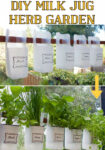Growing your own vegetables is a great way to get outside, stay active, and feed your family delicious, nutritious veggies all summer long. It’s an amazing summer hobby that will leave you happier and healthier.
But what do you do if you don’t have a lot of space? Luckily there are ways around that! Growing a beautiful vegetable garden in a small space is possible. I’m going to give you some layout ideas along with some tips for growing a lot of vegetables in not a lot of space.

Square Foot Gardening
If you’re like me and have your heart set on growing a diverse and plentiful vegetable garden, but you’re limited on space, I highly recommend trying your hand at square foot gardening.
The phrase square foot gardening comes from a book written by Mel Bartholomew. The idea is that instead of a huge plot of land with various vegetables grown in rows that are spaced one to two feet apart, you separate your plot into square feet. Depending on the size of the plant, you can grow anywhere from one to sixteen vegetable plants in a single square foot. Here’s a guide to how many of each vegetable you can plant per square foot. With so many plants growing in a small space, it leaves less room for weeds and is much easier to water and fertilize.
However, for so many plants to thrive in such close quarters, this technique requires very high-quality soil and plenty of sunlight.
It’s usually recommended that square foot gardening is done in a raised bed. This allows you to fill your plot with nutrient-dense, store-bought soil. Twelve inches high is best, but as long as you till the ground below and mix some high-quality soil or fertilizer in with the ground soil, you can get away with a six-inch high bed without a problem.

Raised beds put less strain on your back and knees, provide better drainage, and help keep pests out.
Square foot gardening can also be done in the ground. This requires quite a bit of time and effort because you need to make sure your soil is tilled at least ten to twelve inches deep with PLENTY of nutrients mixed in so that your plants don’t have to compete.
Before you start
- Make sure to choose a spot that gets plenty of sunlight. I watched my backyard for days and took pictures at different times to figure out exactly how many hours of sunlight various areas got throughout the day. Most vegetables require a minimum of six hours of sunlight a day, and eight or more is even better. Some aren’t quite as needy when it comes to sunlight, but make sure to choose a spot where they will get as much sun as possible. Especially if you’re going to try square foot gardening. The more support you can give your plants, the better.
- Test your soil. Especially if you plan on planting directly in the ground. That way you’ll know the quality of soil from the start, and you’ll know what you need to add or adjust for healthy crops. I used the Luster Link Rapitest Test Kit . It’s super simple and tests your soil for ideal pH levels, Nitrogen, Phosphorus, and Potassium with easy to read indicators.
- Plan ahead. Draw your layout. Figure out what you’re going to put where. Plant your climbing vegetables on the north or west side of your garden so they won’t block sun from the smaller plants. Also, keep in mind that certain vegetables do well planted near others, while there are some plants you’ll want to keep apart. Check out this guide to companion planting. If you’re new to gardening and can’t decide what to plant, here are someTips for maximizing your harvest
- Grow vertically. Use a trellis for any veggies that will climb one. You can buy a big, beautiful trellis, or just use tomato cages or stakes. If you can teach your plants to grow upwards, it’ll save you a lot of space. Or, if you’re planning on building a fence to keep the critters out, consider using fencing that could double as a trellis. Check out these fencing ideas for inspiration.
 Tomato cages can work as a trellis for almost any vertically growing vegetables.
Tomato cages can work as a trellis for almost any vertically growing vegetables. - Plant some flowers nearby. Many flowers attract helpful insects that will eat all the pests that would otherwise try to feed on your plants.
 Plant marigolds to keep harmful insects at bay. They’ll also add a cheerful pop of color.
Plant marigolds to keep harmful insects at bay. They’ll also add a cheerful pop of color.- Fertilize. When you have a lot of plants growing in a small area, fertilizing is even more necessary. You’ll want to fertilize your vegetable garden every few weeks. I recommend using a liquid fertilizer so that the nutrients will be more quickly available to your veggies. If you’re trying to keep your garden organic, kelp and fish fertilizer are both great options, or you can make your own liquid fertilizer.

Compost makes great fertilizer. It’s made from purely organic matter, and it’s good for the environment.
- Mulch! Weeds are less of a problem with a square foot garden layout, but mulching can still help your soil retain moisture and regulate temperature. Here are a few cheap mulch ideas that work great.
- Try succession gardening. When a plant is getting close to being ready to harvest, you can start another seedling in the mature veggie’s square. By the time the seedling is big enough to take up significant space, the older plant will be harvested and can be removed to make room. If you plan accordingly, you can harvest two to three crops per square foot over the course of the season.
Vegetable Layout Ideas
 4’x4’ is the simplest layout for a square foot garden, especially if you’re planning on using a raised bed. Most standard raised beds you can buy are this size. Of course, you can build your own raised bed to be any size you want, but keep in mind that most people can comfortably reach about two feet. So don’t make it so wide that you can’t reach the center.
4’x4’ is the simplest layout for a square foot garden, especially if you’re planning on using a raised bed. Most standard raised beds you can buy are this size. Of course, you can build your own raised bed to be any size you want, but keep in mind that most people can comfortably reach about two feet. So don’t make it so wide that you can’t reach the center.Layout 2:

This layout is similar to what I used this year. It can be done in a raised bed or in the ground. The reason I chose this layout is because I needed a fence. Fences are a great way to protect your crops from rabbits and deer. Even more of a threat to mine, however, is my enormous dog and my very busy and very curious toddler. My daughter already picked two beautiful green strawberries off of our plant this year, and I was devastated. I’m not about to let her anywhere near my vegetables.
If deer are a problem for you and you don’t want to build a fence, here are some ideas to keep them away.
Since my garden would be fenced in, I needed to plan it out in a way that would allow me to reach all 34 square feet, which is why I designed it to have a walkway. The layout itself is only two feet wide in every direction, so I can easily tend to all of my plants.
My fence will also be able to double as a trellis for some of my taller plants, although I’ll need extra support for some of the heavier ones.
Layout 3:

If you really want to minimize the amount of space used, you could try this layout and have it run along the back edge of your yard. You could choose to make it either one or two feet wide, and have it go for as long as you want!
Try planting a variety of salad greens along with some crisp vegetables for delicious salads all summer long!
Hopefully these layout ideas inspire you this growing season! Take these ideas and plant yourself a little garden that fits right into what you’re working with. You don’t need a huge plot of land to grow veggies for the whole family all summer long!















